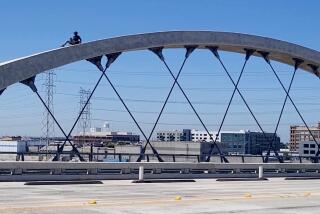Note to tourists: Brooklyn Bridge is for crossing, not climbing
Reporting from New York â Note to tourists: The Brooklyn Bridge is supposed to be crossed, not climbed.
Perhaps signs are needed? But if recent months are any indication, they would need to be written in several languages to quell the fascination some people have with viewing the bridge from above its pedestrian pathway.
On Sunday, a 23-year-old Frenchman became the latest person arrested for clambering over the rails and climbing on one of the cables or towers of the 131-year-old Bridge, which is one of the cityâs most popular tourist draws. The man, identified as Yonatan Souid, faces charges of criminal trespass and reckless endangerment.
Souid said nothing and kept his head slightly bowed as he was led into a police precinct Sunday afternoon after someone alerted police to a man taking pictures from one of the bridgeâs cable beams.
After a court appearance Monday, Souidâs lawyer, James Medows, called Souid a ânaive touristâ who did not deserve to spend time in jail. âHe did something foolish,â Medows said outside court.
Souid was freed after posting bail of $7,000. He was ordered to hand over his passport and to appear back in court on Dec. 9 to face charges of reckless endangerment, criminal trespass and disorderly conduct.
News of Souidâs arrest raised the ire of local officials and once again cast light on what appears to be a problem with security on the bridge, which police say has been under tightened scrutiny since the Sept. 11, 2001, attacks.
That security did not stop Souid from going where he was not supposed to be, and it didnât prevent at least two other breaches in the last year. The most infamous of those occurred in July when interlopers scaled one of the bridge towers and swapped two U.S. flags for flags painted white.
A pair of German artists later claimed in emailed statements to have done the flag swap. They never were arrested.
A month later, police arrested a 24-year-old Russian tourist spotted ascending a support beam connected to the bridge tower on the Brooklyn side. The tourist, Yaroslav Kolchin, made it to the top of the tower, where he took some pictures before climbing safely down and into the waiting arms of law enforcement.
Kolchin was charged with reckless endangerment and criminal trespass. He has since returned to Moscow.
Brooklyn Borough President Eric Adams, speaking to radio station WCBS-AM (880) after the latest incident, said he supports stiffer penalties that would require jail time for people caught scaling the bridge and other city landmarks. âPenalties should be tougher, and that ensures tourists spend time in one of our greatest landmarks: Rikers Island,â Adams said, referring to the cityâs main jail complex.
Brooklyn District Atty. Ken Thompson said he would seek jail time for Souid.
âThis is defendantâs foolish and unlawful conduct is a breach of security and a danger to himself and others,â Thompson said. âIt will not be tolerated. This is not a game and we will be seeking jail time.â
Criminal trespass and reckless endangerment can be either misdemeanors or felonies, depending on the circumstances. But in the case of bridge-climbers, they usually are prosecuted as misdemeanors.
The Brooklyn Bridge and other city tourist attractions have long proved irresistible to pranksters, daredevils and self-proclaimed artists.
Some stunts have become legend, including the French high-wire artist Philippe Petitâs walk between the two towers of the World Trade Center in 1974. The riveting walk more than 1,300 feet above the ground was the subject of the documentary âMan on Wire.â
Most stunts, though, end in embarrassment or worse.
In 2001, a man with a fan-like propeller and parachute on his back launched himself from New Jersey and tried to land on the Statue of Libertyâs torch. From there, he planned to bungee jump to the ground. But Frenchman Thierry Devaux missed the landing, his parachute lines became entangled in the torch, and he dangled above New York Harbor until police could rescue him.
In 1885, Robert Emmet Odlum, an expert swimmer and lifeguard, became the first person to jump from the Brooklyn Bridge, reportedly to show that it was a survivable fall if done correctly. Odlum hit the water at an angle, though, and was killed.
A newspaper article that reported on Odlumâs death the next day carried the headline: âFoolish and Fatal.â
Follow @TinaSusman for national news
More to Read
Sign up for Essential California
The most important California stories and recommendations in your inbox every morning.
You may occasionally receive promotional content from the Los Angeles Times.











